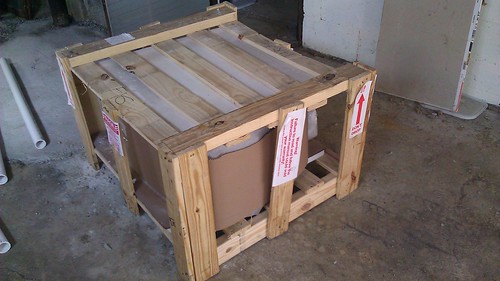If I were a nail biter, I'd be doing it now. I thought that the kiln had some built in schedules for full fuse, tack etc, but I can't seem to find them in the instructions anywhere. It's probably just as good, all considered that I had to enter in my own firing schedule. This way I know exactly what is happening, if I need to make adjustments later. I used a firing schedule that was provided to me during a get to know your kiln class at my local glass shop,
The Glass Place, who in turn got it from
Spectrum Glass.
The schedule I am using is firing at a rate of 300° per hour, until it reaches 1150°, it will then hold that temperature for 30 minutes. This is so that the whole glass piece evens out to the same temperature before going higher. Next, it will fire at a rate of 400° per hour until it reaches 1475°, and I will hold it there for 10 minutes. Somewhere around 1465° - 1500° is when a full fuse takes place. I'm told it can be different for different types of glass and how many layers of glass you are dealing with at the moment. After the full fuse hold, I will let it cool down as fast as it can to 950° and it will hold that for 60 minutes. This will allow the glass to
anneal. It will then ramp down at a rate of 150° and hour to 800° and hold for 10 minutes. To tell the truth, I'm not absolutely sure why they have this step in there. My guess is that it keeps stress out of the glass by letting it cool down slowly. At that point the kiln will turn off and cool at whatever natural rate it will cool to room temperature. This schedule can be written simply as.
| Segment | Ramp | Temp | Hold |
| 1 | 300° | 1150° | 30 |
| 2 | 400° | 1475° | 10 |
| 3 | AFAP | 950° | 60 |
| 4 | 150° | 800° | 10 |
I will probably be writing all future schedules in this manner.
I was advised to go ahead and try to make some things while I was testing out
Full fusing,
slump fusing, tack fusing, and contour fusing. I decided to use some of my scrap glass to make a small dish, for this first attempt. I like the glass in the middle section because it has a nice sparkle in it, that really comes out when fired. I had done a large sushi dish in this same color scheme when I was taking my fusing class way back when, so this is being put to a good use. If it turns out, I may gift it to the same people I gave the other piece to, so they have a sauce dish. Who knows, the whole thing may blow up to!












